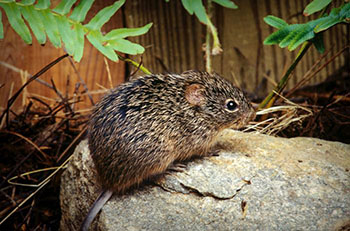NIEHS' Pat the Rat: The Tail of a Cotton Rat
By Bill Willis and John McLamb
May 16, 2014

Photo courtesy of James Gathany
There have been numerous sightings of rats along the walkway between the south parking lot and A module. After investigating, it was determined that these rats are native Hispid Cotton Rats. The cotton rat prefers areas of dense vegetation such as grassy fields, fence rows adjacent to fields and overgrown ditch banks. Unlike Norway rats, the cotton rats are not structural pests, preferring to live away from humans. The water inundation of the brickwork along the employee walkways may have contributed to additional sightings.
The Hispid Cotton Rat (genus Sigmodon hispidus) is widely distributed in South America, Central America, as well as southern North America. Only recently with the availability of mitochondrial DNA sequencing has it been determined that this animal is actually three individual species (S. hispidus, S. toltecus, and S. hirsutus)[Carrill et al. 2004]. The species found in North Carolina is S. hispidus which occupies dense grassy locations that have some brushy cover. While considered nocturnal, they may be seen moving around during the day. The female constructs a grass-lined nest at or just below ground level (burrow, log, brick pavers). Twenty seven days after mating, litters of up to 15 pups are born. Neonates are well developed at birth, active, with their eyes beginning to open by 18 hours. Depending on the litter size, pups can be weaned as early as day 10. Females are mature at 30 days, males at 60 days. Like our laboratory mice, the females have post-partum estrus. The average life span is 6 months in the wild with the exception being 12 months.
Hispid cotton rats are omnivorous, with the major portion of their diet coming from green plants (stems, leaves, seeds, roots, fruits). An occasional insect or invertebrate may be on the menu. Population density is related to suitable habitat (food, water, shelter) and predatory pressures. These rats are part of the food-chain of birds (hawks, owls), red foxes, reptiles, and bobcats. They’re known to keep field mice populations down.
In the 1930’s Dr. Charles Armstrong at NIH selected the cotton rat as a small animal model for the study of the polio. Since that time it has been used to study a wide range of infectious diseases including typhus, filariasis, and respiratory syncytial virus (RSV). Most recently, the cotton rat model has been used to study and develop treatments for infections from influenza and rhinovirus.
Our options to prevent or control these animals could include the following: physical exclusion, cultural modification to the habitat, repellents, toxicants, fumigants, or trapping. None of these is guaranteed to work, and some approaches require special permits and are hazardous to other native species. Our plan, after consulting with the NC Wildlife Commission Biologist and our Institute exterminator, is to monitor, but not to employ any action beyond possible habitat modification to encourage the cotton rats to move to another location. This policy is in compliance with our wildlife and industry stewardship aims and goals as well as the Integrated Pest Management Plan.
There is a remote possibility that the rat could carry the hantavirus pulmonary syndrome (HPS) virus so like most wildlife, it’s best not to feed or handle them.
If you have any questions concerning pest control, please call John McLamb at 1-4235. Bill Willis is the Wildlife and Industry Together (WAIT) coordinator.
Sources



